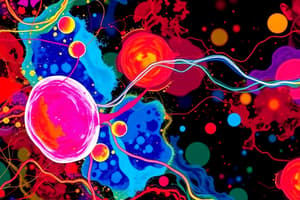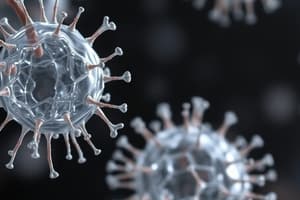Podcast
Questions and Answers
What is primarily responsible for regulating gene expression in intracellular communication?
What is primarily responsible for regulating gene expression in intracellular communication?
- Signal transduction pathways (correct)
- Cell surface receptors
- Intracellular junctions
- Hormonal binding
Which of the following molecules is considered a second messenger in intracellular signaling?
Which of the following molecules is considered a second messenger in intracellular signaling?
- Cytokines
- Growth factors
- Hormones
- cAMP (correct)
What type of cell-to-cell communication involves cells releasing signaling molecules that affect nearby cells?
What type of cell-to-cell communication involves cells releasing signaling molecules that affect nearby cells?
- Endocrine signaling
- Autocrine signaling
- Juxtacrine signaling
- Paracrine signaling (correct)
Which of the following best describes intercellular communication?
Which of the following best describes intercellular communication?
Which mechanism is NOT associated with intracellular communication?
Which mechanism is NOT associated with intracellular communication?
How do endocrine hormones reach their target tissues?
How do endocrine hormones reach their target tissues?
What is a common characteristic of all signal molecules involved in intercellular communication?
What is a common characteristic of all signal molecules involved in intercellular communication?
Which signaling pathway involves the release of calcium ions as a crucial step?
Which signaling pathway involves the release of calcium ions as a crucial step?
What type of signaling involves a cell producing signaling molecules that act on itself?
What type of signaling involves a cell producing signaling molecules that act on itself?
Which of the following statements accurately describes the comparison between endocrine and paracrine signaling?
Which of the following statements accurately describes the comparison between endocrine and paracrine signaling?
What is a key characteristic that distinguishes synaptic signaling from direct signaling?
What is a key characteristic that distinguishes synaptic signaling from direct signaling?
Which type of signaling primarily features a rapid response system affecting only neighboring cells?
Which type of signaling primarily features a rapid response system affecting only neighboring cells?
In the context of autocrine signaling, what role does it play in cellular activities?
In the context of autocrine signaling, what role does it play in cellular activities?
Which of the following best describes the function of ligand-gated ion channels?
Which of the following best describes the function of ligand-gated ion channels?
What distinguishes G protein-coupled receptors (GPCRs) from ligand-gated ion channels?
What distinguishes G protein-coupled receptors (GPCRs) from ligand-gated ion channels?
Which of the following correctly illustrates the specificity of signaling mechanisms?
Which of the following correctly illustrates the specificity of signaling mechanisms?
What role does feedback play in autocrine signaling?
What role does feedback play in autocrine signaling?
What is the immediate result of epidermal growth factor (EGF) binding to the epidermal growth factor receptor (EGFR)?
What is the immediate result of epidermal growth factor (EGF) binding to the epidermal growth factor receptor (EGFR)?
Which protein is directly responsible for facilitating the exchange of GDP for GTP on Ras?
Which protein is directly responsible for facilitating the exchange of GDP for GTP on Ras?
How does activated Ras initiate the MAP kinase cascade?
How does activated Ras initiate the MAP kinase cascade?
Which of the following best describes the role of Gefitinib in the context of EGFR signaling?
Which of the following best describes the role of Gefitinib in the context of EGFR signaling?
Which component is NOT a part of the PI3K-AKT signaling pathway?
Which component is NOT a part of the PI3K-AKT signaling pathway?
What role does cGMP play in cellular responses after being produced by guanylyl cyclase receptors?
What role does cGMP play in cellular responses after being produced by guanylyl cyclase receptors?
Which of the following describes the activation process of receptor tyrosine kinases (RTKs)?
Which of the following describes the activation process of receptor tyrosine kinases (RTKs)?
What is one function of soluble guanylyl cyclase (sGC) when activated by nitric oxide (NO)?
What is one function of soluble guanylyl cyclase (sGC) when activated by nitric oxide (NO)?
Which domain of receptor tyrosine kinases directly facilitates the phosphorylation process?
Which domain of receptor tyrosine kinases directly facilitates the phosphorylation process?
What is the primary function of the extracellular domain of receptor tyrosine kinases?
What is the primary function of the extracellular domain of receptor tyrosine kinases?
How do phosphorylated tyrosines in RTKs affect cellular signaling pathways?
How do phosphorylated tyrosines in RTKs affect cellular signaling pathways?
What initiates the activation of the Ras-MAP kinase cascade through the EGFR receptor?
What initiates the activation of the Ras-MAP kinase cascade through the EGFR receptor?
What distinguishes membrane-bound guanylyl cyclase receptors from soluble guanylyl cyclase?
What distinguishes membrane-bound guanylyl cyclase receptors from soluble guanylyl cyclase?
What effect does increasing intracellular cGMP have on vascular smooth muscle?
What effect does increasing intracellular cGMP have on vascular smooth muscle?
Which of the following correctly describes the general structure of receptor tyrosine kinases (RTKs)?
Which of the following correctly describes the general structure of receptor tyrosine kinases (RTKs)?
What happens to the α subunit of a G-protein after GTP binding?
What happens to the α subunit of a G-protein after GTP binding?
Which enzyme is activated by the Gαs subunit and is responsible for converting ATP to cyclic AMP?
Which enzyme is activated by the Gαs subunit and is responsible for converting ATP to cyclic AMP?
What are the two second messengers produced by the activation of Phospholipase C?
What are the two second messengers produced by the activation of Phospholipase C?
What effect does IP3 have after being produced by Phospholipase C activation?
What effect does IP3 have after being produced by Phospholipase C activation?
Following the activation of Protein Kinase C (PKC) by DAG, which cellular responses can PKC influence?
Following the activation of Protein Kinase C (PKC) by DAG, which cellular responses can PKC influence?
What is the role of the βγ subunits in G-protein signaling?
What is the role of the βγ subunits in G-protein signaling?
What initiates the inactivation of the α subunit of a G-protein?
What initiates the inactivation of the α subunit of a G-protein?
What is a key role of calcium after being released into the cytoplasm?
What is a key role of calcium after being released into the cytoplasm?
Which of the following describes the immediate downstream effect of cAMP in G-protein signaling?
Which of the following describes the immediate downstream effect of cAMP in G-protein signaling?
How does the G-protein signaling pathway return to its inactive state?
How does the G-protein signaling pathway return to its inactive state?
Flashcards are hidden until you start studying
Study Notes
Cell Communication Fundamentals
- Cellular communication involves detection, interpretation, and response to signals from the environment, critical for homeostasis, growth coordination, and environmental response.
Intercellular vs. Intracellular Communication
-
Intracellular Communication: Occurs within a single cell; involves signal transduction pathways, second messengers (e.g., cAMP, Ca²⁺), and gene expression regulation.
-
Signal Transduction Pathways: Triggered by signals such as hormone binding leading to cellular responses.
-
Examples of Intracellular Mechanisms:
- cAMP Pathway: Activates protein kinase A (PKA) to phosphorylate target proteins.
- Calcium Signaling: Triggers muscle contraction and neurotransmitter release.
-
Intercellular Communication: Occurs between different cells; involves signal molecules, receptors, and direct cell connections (e.g., gap junctions).
-
Examples of Intercellular Mechanisms:
- Paracrine Signaling: Affects nearby cells within the same tissue.
- Endocrine Signaling: Hormones travel through the bloodstream to distant organs.
- Autocrine Signaling: Cell produces signals acting on itself for self-regulation.
- Direct Signaling: Involves cell contact for signaling molecule interaction.
- Synaptic Signaling: Neurotransmitter release across a synapse targeting adjacent cells.
Comparison of Signaling Mechanisms
-
Endocrine vs. Paracrine:
- Endocrine signals travel long distances; paracrine signals act locally.
- Endocrine responses are slower; paracrine responses are quicker.
- Endocrine signaling is less specific compared to paracrine signaling.
-
Paracrine/Endocrine vs. Autocrine:
- Paracrine signals target nearby cells; endocrine signals target distant cells; autocrine signals target the signaling cell itself.
- Autocrine signaling often involves feedback loops for regulation.
-
Direct vs. Synaptic Signaling:
- Direct signaling relies on cell contact; synaptic signaling uses neurotransmitter release.
- Synaptic signaling is highly specific, while direct signaling can affect any adjacent cell with the appropriate receptor.
Receptor Types and Functions
-
Ligand-Gated Ion Channels: Form a pore in the plasma membrane activated by ligands, facilitating ion flow.
-
G Protein-Coupled Receptors (GPCRs):
- Bind ligands to activate G-proteins (GTP-bound active state).
- Produce second messengers like cAMP and initiate intracellular signaling cascades.
Key Enzymes and Second Messengers in GPCR-Mediated Responses
- Adenylate Cyclase: Converts ATP to cyclic AMP (cAMP) when activated, leading to various cellular responses.
- Phospholipase C (PLC):
- Activates second messengers IP3 and DAG, crucial for calcium signaling.
- IP3 promotes calcium release from the endoplasmic reticulum; DAG activates protein kinase C (PKC) for multiple cellular functions.
Catalytic Receptor Signaling
- Guanylyl Cyclase Receptor:
- Activated by ligands (e.g., nitric oxide), converts GTP to cGMP, acting as a second messenger for various cellular processes.
- Receptor Tyrosine Kinases (RTKs):
- Dimerize upon ligand binding, leading to autophosphorylation that propagates downstream signaling affecting growth and survival.
Activation of the Ras-MAP Kinase Cascade
- EGFR Activation: Binding of EGF induces receptor dimerization and tyrosine autophosphorylation.
- Recruitment of Adapter Proteins: Phosphorylated EGFR recruits Grb2 and Sos to activate Ras.
- MAP Kinase Cascade: Activated Ras initiates a cascade leading to gene regulation involved in cell growth and differentiation.
Clinical Relevance
- Dysregulated tyrosine kinase signaling is linked to diseases like cancer and Alzheimer’s disease.
EGFR Signaling and Inhibition
- Gefitinib: An EGFR inhibitor that impacts transcription factors like Myc, Jun, and Fos, influencing cellular responses and growth.
PI3K-AKT Signaling Pathway
- Includes key components PI3K, AKT, Foxo, and mTOR, crucial for cell survival and growth regulation.
- PTEN and mTOR Inhibitors: Are potential therapeutic targets for cancer treatment due to their roles in cell growth regulation.
Nuclear Receptors
- Interact with five major steroid hormones, regulating gene transcription.
- Examples of Nuclear Receptors: Androgen receptors and thyronine receptors are critical for regulating gene expression in response to hormones.
Studying That Suits You
Use AI to generate personalized quizzes and flashcards to suit your learning preferences.




